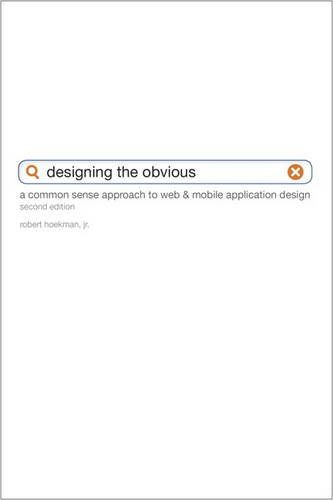Designing the Obvious Book Summary
In 'Designing the Obvious', Robert Hoekman Jr. unveils the hidden principles of intuitive design that captivate users from the first glance. The book dissects the art of simplicity, revealing how the most effective designs are often the most straightforward. Through insightful anecdotes and practical tips, Hoekman challenges conventional wisdom and emphasizes the importance of understanding user needs. Readers will discover how to create seamless experiences that enhance interaction and foster engagement. This compelling exploration of design urges us to rethink our approach and emphasizes that the simplest solutions can have the most profound impact.
By Robert Hoekman (Jr.), Robert Hoekman
Published: 2011
"Good design doesn’t just happen; it’s the result of diligent thought, careful observation, and an unyielding commitment to making the obvious clear."
Book Review of Designing the Obvious
Designing the Obvious belongs in the toolbox of every person charged with the design and development of Web-based software, from the CEO to the programming team. Designing the Obvious explores the character traits of great Web applications and uses them as guiding principles of application design so the end result of every project instills customer satisfaction and loyalty. These principles include building only whats necessary, getting users up to speed quickly, preventing and handling errors, and designing for the activity. Designing the Obvious does not offer a one-size-fits-all development process--in fact, it lets you use whatever process you like. Instead, it offers practical advice about how to achieve the qualities of great Web-based applications and consistently and successfully reproduce them. This latest edition updates examples to show the guiding principles of application design in action on today's web, plus adds new chapters on strategy and persuasion. It offers practical advice about how to achieve the qualities of great Web-based applications and consistently and successfully reproduce them.
Book Overview of Designing the Obvious
About the Book Authors
Robert Hoekman (Jr.)
Robert Hoekman (Jr.) is an accomplished author and designer renowned for his contributions to the fields of interaction design and user experience. He is the author of several influential books, including 'Designing the Obvious' and 'Interface Culture', which explore the intersection of technology and design with a focus on creating intuitive user experiences. His writing style is characterized by clear, engaging prose that makes complex concepts accessible to a wide audience. With a passion for usability and a keen insight into modern design practices, Robert continues to write and speak on topics related to design, innovation, and the future of technology.
Robert Hoekman
Robert Hoekman (Jr.) is an accomplished author and designer renowned for his contributions to the fields of interaction design and user experience. He is the author of several influential books, including 'Designing the Obvious' and 'Interface Culture', which explore the intersection of technology and design with a focus on creating intuitive user experiences. His writing style is characterized by clear, engaging prose that makes complex concepts accessible to a wide audience. With a passion for usability and a keen insight into modern design practices, Robert continues to write and speak on topics related to design, innovation, and the future of technology.
Book Details
Key information about the book.
- Authors
- Robert Hoekman (Jr.), Robert Hoekman
- Published
- January 2011
- Publisher
- Pearson Education
- ISBN
- 0321749855
- Language
- English
- Pages
- 305
- Genres
- Design ThinkingDesign
Purchase Options
Support local bookstores: BookShop gives a portion of each sale to independent bookshops!
Similar books you might like →
The New Intifada Book Summary
'The New Intifada' by Roane Carey unveils the complex and turbulent landscape of the Palestinian struggle for freedom. Through a collection of compelling essays, it highlights the voices of those directly impacted by the conflict, shedding light on their hopes and despair. Carey's incisive analysis challenges dominant narratives and reveals the intricacies of resistance and resilience. This provocative book invites readers to grapple with the moral ambiguities of the situation, making it essential for anyone seeking understanding in a polarized world. Will you dare to confront the reality behind the headlines?
The Designer's Dictionary of Type Book Summary
Delve into the fascinating world of typography with 'The Designer's Dictionary of Type' by Sean Adams. This comprehensive guide unravels the intricacies of typefaces, revealing their unique personalities and historical contexts. Each entry offers insights that inspire creativity and enhance design skills, making it an essential reference for both novice and seasoned designers. With stunning visual examples, the book encourages a deeper appreciation for the art and science of type. Discover how the right type can transform your work and captivate your audience!
Designing with Type, 5th Edition Book Summary
Dive into the art and science of typography with 'Designing with Type, 5th Edition'. This essential guide unravels the intricacies of typefaces, spacing, and layout, empowering designers to elevate their work. Through a rich blend of practical insights and illustrative examples, Craig and Scala reveal how type influences design perception. Whether you’re a novice or a seasoned professional, this book opens your eyes to the transformative power of typography. Discover how to shape your visual communication and captivate your audience with every word.
The Design of Everyday Things Book Summary
In 'The Design of Everyday Things', Don Norman reveals the hidden principles behind effective design that shapes our everyday interactions. He explores the psychological underpinnings of how we perceive and interact with objects, highlighting the importance of usability and user-centered design. Through captivating examples, Norman illustrates how poor design can lead to frustration, while thoughtful design enhances our experience. This book challenges readers to rethink the functionality of everyday items, making them consider the design choices behind the objects they encounter. Ultimately, it invites us to demand better designs that cater to our needs, making the mundane extraordinary.
Don't Make Me Think, Revisited Book Summary
In 'Don't Make Me Think, Revisited', Steve Krug presents a timeless guide to web usability, challenging the notion that users read websites thoroughly. With humor and clarity, he emphasizes the importance of intuitive design, advocating that simplicity trumps complexity. Krug's insights encourage designers to prioritize user experience, making navigation as effortless as possible. Through practical examples and actionable advice, he unveils common pitfalls to avoid. This essential read will transform the way you think about designing websites and engaging users—are you ready to rethink your approach?
100 Things Every Designer Needs to Know about People Book Summary
In '100 Things Every Designer Needs to Know about People,' Susan Weinschenk unveils essential psychological principles that can enhance design effectiveness. With insights drawn from cognitive science, the book explores how people perceive, interact with, and make decisions about design. From the nuances of color perception to the importance of empathy in user experience, Weinschenk offers practical strategies for designers. Each principle is supported by fascinating research, making the content both informative and engaging. This enlightening guide equips designers to create more intuitive and user-friendly experiences, sparking curiosity about the intersection of psychology and design.
The Elements of Scrum Book Summary
Delve into the transformative world of Scrum with 'The Elements of Scrum,' where authors Chris Sims and Hillary Louise Johnson unravel the principles that drive agile project management. This insightful guide not only explains the core components of the Scrum framework but also illustrates how they can revolutionize teamwork and productivity. Through vivid examples and practical tips, you’ll discover how to foster collaboration and innovation in any environment. Whether you’re a novice or a seasoned practitioner, the book challenges conventional approaches and ignites a passion for continuous improvement. Are you ready to embrace agility and unleash your team's potential?
Gamification by Design Book Summary
In 'Gamification by Design', the authors explore the art and science of integrating game mechanics into non-game contexts to enhance user engagement and motivation. They uncover the psychology behind what makes games addictive and how these principles can be applied to real-world scenarios. Through practical case studies and actionable frameworks, the book reveals how gamification can be a catalyst for innovation and user loyalty. Are you ready to unlock the secrets of game mechanics and transform your projects? Dive into this insightful read to discover how to design experiences that captivate and retain users!
Showing 8 of 28 similar books
Similar Book Recommendations →

Melanie Perkins's Book Recommendations
Melanie Perkins is an Australian technology entrepreneur and the co-founder and CEO of Canva, an online design and publishing tool that has revolutionized the graphic design industry. Born in Perth, Australia, she launched Canva in 2013 with the aim of making design accessible to everyone, regardless of their skill level. Under her leadership, Canva has grown to serve millions of users worldwide and has reached a multi-billion-dollar valuation. Perkins' innovative approach and dedication to user-friendly design have earned her recognition as one of the most influential women in technology. Beyond her entrepreneurial success, she is also a passionate advocate for diversity and inclusion in the tech industry.

Julian Shapiro's Book Recommendations
Julian Shapiro is a renowned writer and entrepreneur, acclaimed for his insightful essays on personal growth and marketing strategies. He is the author of "The Julian Shapiro Collection," a compilation of his most impactful writings that have garnered a wide readership online. Shapiro co-founded the growth marketing agency Bell Curve, where he has helped numerous startups achieve exponential growth. His work often blends practical advice with deep philosophical inquiries, making complex subjects accessible to a broad audience. Through his prolific writing and entrepreneurial ventures, Julian has become a key figure in the intersection of business and self-improvement literature.

Bret Victor's Book Recommendations
Bret Victor is a renowned American interface designer and computer scientist celebrated for his innovative contributions to interactive design and human-computer interaction. He is best known for creating dynamic, explorable explanations, which have significantly influenced the way educational content is presented and understood. Victor's seminal work, "Inventing on Principle," advocates for the integration of immediate feedback in creative processes, inspiring a new wave of interactive programming environments. As a former member of the Apple Human Interface team, he played a pivotal role in shaping modern user interfaces. Through his organization, Dynamicland, Victor continues to explore and expand the boundaries of immersive, collaborative computing environments.

Coleen Baik's Book Recommendations
Coleen Baik is an American designer, artist, and entrepreneur, known for her work in the tech industry, including as a founding team member of Twitter. Baik played a key role in shaping the user experience and design of Twitter in its early days, contributing to its iconic interface. She is also the founder of Baik Art, a multidisciplinary art studio that blends technology and visual art. Baik is passionate about using design to create meaningful and user-centered digital experiences, and she frequently speaks on topics related to innovation, design, and creativity. Her work has made her a prominent figure in the intersection of tech and design.

Andrew Chen's Book Recommendations
Andrew Chen is a venture capitalist, entrepreneur, and thought leader in growth marketing, currently serving as a general partner at Andreessen Horowitz. Chen is known for his expertise in network effects, viral growth strategies, and marketplace dynamics, making him a sought-after advisor for startups looking to scale. Prior to joining Andreessen Horowitz, he worked in leadership roles at Uber, helping to grow the ride-sharing platform’s user base and develop key growth strategies. Chen is also a prolific writer, sharing his insights on growth, technology, and startups through his popular blog and newsletter, which has attracted a loyal following in the tech community. His work has helped shape how many startups approach user acquisition, retention, and product-market fit. As a venture capitalist, Chen focuses on early-stage companies in the consumer internet, SaaS, and marketplace sectors, and he has been involved in funding and advising several successful startups. His insights on technology and growth continue to influence both founders and investors alike.

Daniel Burka's Book Recommendations
Daniel Burka is a prominent figure in the tech and design world, best known for his significant contributions to digital product design. As a design partner at GV (formerly Google Ventures), he has played a crucial role in shaping the user experience of numerous successful startups. Burka co-founded the design agency MetaLab, which has worked with top-tier clients like Slack and Coinbase. Additionally, his work at Digg as the Director of Design helped pioneer social media design trends in the early 2000s. While not primarily an author, Burka's influence extends into literature through his insightful writings and talks on design and innovation.

Jason Fried's Book Recommendations
Jason Fried is an influential entrepreneur and author best known as the co-founder and CEO of Basecamp, a project management and team collaboration software company. He has notably co-authored several best-selling books, including "Rework" and "Remote: Office Not Required," which challenge conventional business practices and advocate for more efficient, flexible work environments. Fried's clear, straightforward writing style has resonated with a wide audience, making complex business concepts accessible. His work has significantly contributed to the discourse on modern work culture and productivity. Fried continues to influence contemporary business thought through his writing and leadership at Basecamp.

Chris Do's Book Recommendations
Chris Do is a renowned designer, entrepreneur, and educator, best known for his influential work in the fields of design and business strategy. As the founder and CEO of The Futur, an online education platform, he has revolutionized the way creative professionals learn about design, branding, and entrepreneurship. Do's contributions extend beyond education; his insightful writings on design thinking and business acumen have garnered a global following. Additionally, he has received numerous accolades for his innovative approach to design and his commitment to empowering the creative community. Through his books, articles, and speaking engagements, Chris Do continues to inspire and mentor the next generation of designers and entrepreneurs.
Showing 8 of 23 related collections
“Good design doesn’t just happen; it’s the result of diligent thought, careful observation, and an unyielding commitment to making the obvious clear.”
Designing the Obvious
By Robert Hoekman (Jr.), Robert Hoekman
Frequently Asked Questions
Explore Our Catalogue
Discover a world of knowledge through our extensive collection of book summaries.
Genres
Genres
Genres
Featured Collections
- Top Book Club Picks
- One-Stop Nutrition
- Summer Reads 2024
- Best Beach Reads 2024
- Work-Life Balance Guide
- Time Management
- Healthy Foods
- Entrepreneur Toolkit
- Mind & Body Wellness
- Future Tech Insights
- Leadership Essentials
- Financial Freedom
- Sci-Fi Masterpieces
- Parenting 101
- Books That Became Blockbusters
- Guide to a Healthy Pregnancy










